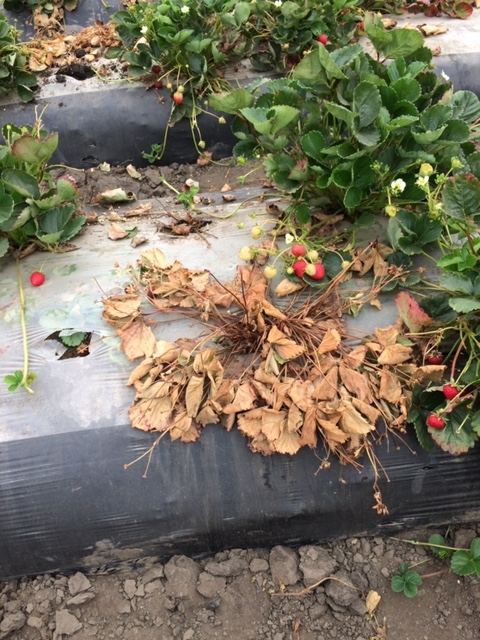
- Author: Mark Bolda
Introduction: The difficulty of controlling Macrophomina, the causal agent in charcoal rot in strawberry, in California has brought about a renewed interest in non-conventional methods for its management.
The following study is an attempt to investigate two soil applied fungicides and their effectiveness in mitigating loss from Macrophomina infection.
Materials and Methods: The trial was done as a randomized complete block design of four replicates of one bed 35 foot long by 4 foot wide per treatment on Monterey variety strawberries in a field known to be infested with Macrophomina in Salinas, California. See the picture below for a demonstration of the disease severity of the disease on one side of the field; the side on which the study was done was unfortunately (for the study, not the grower) not nearly as severe.
Application: Applications of both fungicides were done 3 times in the early part of the year, March 2, April 12 and May 3, 2017. The fungicide Rhyme (which is labeled for soil application for management of charcoal rot), applied at 7 oz/acre and Merivon, applied at 11 oz/acre, were applied in approximately 40 gallons of water per treatment pumped in with a gasoline powered pump hooked up to the double rows of high flow drip tape. Injection consisted priming the irrigation tape, injecting the material and then flushing the lines.
It is important to note that the use pattern deployed here for Merivon is as of this time NOT a labeled application.
Evaluation:
Plant diameters were taken in the early part of the season to gauge any initial differences in plant vigor. One measurement across the widest part of ten plants was taken in each treatment replicate and reported in cm.
Yield of strawberry fruit was the principle measure of plant performance in this trial. Fruit picking commenced in May with weekly picks, and then continued from June through early September with twice weekly picks. Only marketable fruit was included, and it was weighed and counted from each plot.
Since the work here involved two fungicides, one evaluation of powdery mildew was also done on May 9, 2017 but the amount of mildew was insufficient for a significant evaluation.
Results were tested statistically on ARM version 9 using a multiple comparison procedure (Least Significant Difference at the 95 percent level of significance) to determine whether the means of counts and percentages per treatment were significantly higher or lower from the other treatments.
Results and Discussion:
Results are given in Tables 1 and 2 below. While disease was evident with weakening plants from the beginning of May on, it was not as severe as the outbreak on the other side of the field and no plants were lost in any of the treatments.
Table 1: Plant Diameters on Two Dates (in cm) of Strawberry in Plots of Soil Applied Fungicides Rhyme and Merivon Compared to an Untreated Check1
|
Treatment |
Apr 12 |
May 3 |
|
Untreated |
32.2 a |
33.1 a |
|
Rhyme |
32.7 a |
34.7 a |
|
Merivon |
32.7 a |
35.7 a |
Table 2: Fruit Yield and Size (in g) of Strawberry in Plots of Soil Applied Fungicides Rhyme and Merivon Compared to an Untreated Check1
|
Treatment |
May totl |
May size |
June totl |
June size |
July totl |
July size |
|
Untreated |
2214a |
35.6 a |
4408a |
28.4 a |
5636a |
21.0 a |
|
Rhyme |
2169a |
35.3 a |
4720a |
28.1 a |
5525a |
21.9 a |
|
Merivon |
2216a |
34.6 a |
4454a |
27.9 a |
6064a |
22.1 a |
|
Treatment |
Aug totl |
Aug size |
Sept total |
Sept size |
Season total |
Size avg |
|
Untreated |
3051a |
21.2b |
849.0a |
20.9 b |
16157a |
24.1 a |
|
Rhyme |
2617a |
22.2a |
784.5a |
21.5 ab |
15816a |
24.8 a |
|
Merivon |
2752a |
21.9a |
1009a |
22.3 a |
16496a |
24.6 a |
1Method used to discriminate among means Fisher's least significant difference procedure. Treatments followed by the same letter have no statistically significant differences.
As seen in the tables above, use of the soil applied fungicides in this trial did not result in any significant yield differences between any of the treatments. It is interesting to note however, that average fruit size in the later months of the study, those being August and September, was significantly larger in the treated plots than the untreated.
Many thanks to the grower, BASF and FMC for really great support on getting this trial done.
The use of several pesticides is described in this post. As always, before using any of these or other pesticides, consult the label and if there are further questions contact your local County Agricultural Commissioner.



On another note, save Feb 14 as the date for the Annual Strawberry Production Research meeting. I've got a line up of scientists presenting that will absolutely blow your mind, so make sure to be there!